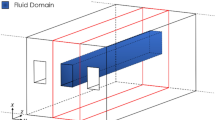Abstract
Following up ideas put forward by J.M. Ottino and colleagues, the possibility of designing a computational tool to optimize the mixing of viscous fluids in industrial devices is studied. It is shown that an efficient method to characterize and quantify a mixing process is to apply the statistical measures introduced by Danckwerts (e.g., intensity of segregation and scale of segregation) on the coarse-grained density distribution of points in Poincaré sections and advection patterns, that can be obtained by tracking the positions of marked fluid elements numerically. This method is not computationally excessively costly and, as is demonstrated here, can be applied easily to experimental dye advection studies. The model system used is the Stokes flow in a two-dimensional cavity transfer mixer: two rectangular cavities which are periodically driven by a solid wall and by the passage of the cavities over each other. This system shares with many industrial devices the complexity that the geometry of the flow is time-dependent. These changes in the geometry of the flow impose difficulties on the techniques of calculating the fluid velocity field (a boundary element method) and the advection of marked fluid elements. Ways of overcoming these difficulties are described.
Similar content being viewed by others
References
Spencer, R.S. and Wiley, R.H., The mixing of very viscous fluids. J. Colloid Sci. 133 (1951) 133–145.
Danckwerts, P.V., The definition and measurement of some characteristics of mixtures. Appl. Sci. Res. 3 (1952) 279–296.
Bigg, D. and Middleman, S., Mixing in a screw extruder: A model for residence time distribution and strain. Ind. Engrg. Chem. Fundam. 13 (1974) 66–71.
Aref, H., Stirring by chaotic advection. J. Fluid Mech. 143 (1984) 1–21.
Ottino, J.M., Leong, C.W., Rising, H. and Swanson, P.D., Morphological structures produced by mixing in chaotic flows. Nature 333 (1988) 419–425.
Ottino, J.M., The mixing of fluids. Sci. Amer. 260 (1989) 56–67.
Ottino, J.M., The Kinematics of Mixing: Stretching, Chaos and Transport. Cambridge University Press, Cambridge (1989).
Ottino, J.M., Mixing, chaotic advection, and turbulence. Ann. Rev. Fluid Mech. 22 (1990) 207–253.
Ottino, J.M., Unity and diversity in mixing: Stretching, diffusion, breakup, and aggregation in chaotic flows. Phys. Fluids A 3 (1991), 1417–1430.
Ottino, J.M., Muzzio, F.J., Tjahjadi, M., Franjione, J.G., Jana, S.C. and Kusch, H.A., Chaos, symmetry, and self-similarity: Exploiting order and disorder in mixing processes. Science 257 (1992) 754–760.
Jana, S.C., Metcalfe, G. and Ottino, J.M., Experimental and computational studies of mixing in complex Stokes flows: The vortex mixing flow and multicellular cavity flows. J. Fluid Mech. 269 (1994) 199–246.
Hilborn, R.C., Chaos and Nonlinear Dynamics, An Introduction for Scientists and Engineers. Oxford University Press, Oxford (1994).
Woering, A.A., The optimization of mixing of viscous fluids. Ph.D. Thesis, University of Twente (1997).
Pozrikidis, C., Boundary Integral and Singularity Methods for Linearized Viscous Flow. Cambridge University Press, Cambridge (1992).
Burggraf, O., Analytical and numerical studies of the structure of steady separated flows. J. Fluid Mech. 24 (1966) 113–151.
Pan, F. and Acrivos, A., Steady flows in rectangular cavities. J. Fluid Mech. 28 (1967) 643–655.
Gupta, M.M. and Manohar, R.P., Boundary approximations and accuracy in viscous flow computations. J. Comput. Phys. 31 (1979) 265–288.
Rodriguez-Prada, H.A., Pirouti, F.F. and Saez, A.E., Fundamental solutions of the streamfunction-vorticity formulation of the Navier-Stokes equations. Internat. J. Numer. Methods Fluids 10 (1990) 1–12.
Press, W., Teukolsky, S.A., Vetterling, W.T. and Flannery, B.P., Numerical Recipes in C. Cambridge University Press, Cambridge (1988).
Souvaliotis, A., Jana, S.C. and Ottino, J.M., Potentialities and limitations of mixing simulations. AIChEJ 41 (1995), 1605–1621.
Rights and permissions
About this article
Cite this article
Woering, A., Gorissen, W. & Biesheuvel, A. Optimization of Viscous Mixing in a Two-Dimensional Cavity Transfer Mixer. Flow, Turbulence and Combustion 60, 377–407 (1998). https://doi.org/10.1023/A:1009940909377
Issue Date:
DOI: https://doi.org/10.1023/A:1009940909377




